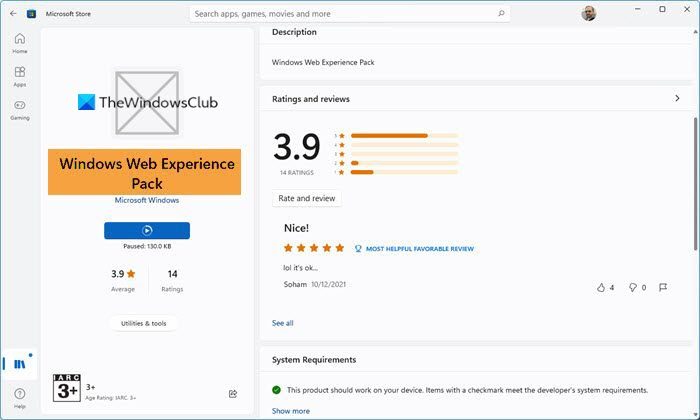Recently a lot of users have been witnessing something that has no explanation. Apparently, something known as Windows Web Experience Pack was released to Windows 11/10 users via Windows Update, but strangely enough, no one could find any form of information about it. With that in mind, we chose to scour the internet to find out what this Windows Web Experience Pack is all about, and whether or not it’s something you should worry about.
Windows Web Experience Pack

OK, so we believe the Windows Web Experience Pack won’t be found on every computer running Windows 11. Chances are, it may depend on your version of Windows 11 or Windows 10 and possibly your hardware specs.
Now, to find out if this service is already installed, the best way to know is to fire up the Microsoft Store from the Taskbar, then search for Windows Web Experience Pack. If you can find it from within the Store, then you either have it and it says Installed – or the option is there for you to Download.
Which version of Windows supports the Windows Web Experience Pack?
At the time of writing, we can say for 100 percent certainty that the Windows Web Experience Pack is only available for Windows 11/10 operating systems. It comes to both operating systems in the form of an update, though on Windows 11, you have the option to get it from the Store.
When was the Windows Web Experience Pack first introduced?
From our investigation on the web, it would seem as if the Web Experience Pack was first brought to the forefront in Windows 10’s May 2020 Update, version 2004.
What is the Windows Web Experience Pack?
Here’s the thing, Microsoft no longer wants to tie everything to Windows, and that’s a good thing. We suspect the company will continue down this road for the foreseeable future in order to make updates more seamless.
The pack is expected to offer faster updates for certain web-related components of Windows OS. As you can tell, Microsoft Edge is a separate entity from the operating system, which is why the software giant can release updates for it more often. This was not possible with Internet Explorer and the original version of Edge.
So, similarly to the Windows Feature Experience Pack, we believe the Web Experience Pack is designed to allow Microsoft to update certain components of Windows 11/10 independently of the operating system.
In fact, there are other Experience Packs outside the two mentioned here, for example, the Local Experience Pack and Online Service Experience Packs. Each one is capable of being updated without having to wait until Windows itself needs an update.
Microsoft has yet to give any detail regarding this particular Experience Pack. However, our investigation leads us to believe it has something to do with the new Widgets feature. Still, we could be wrong about here but worry not because we will continue to update this article with new information whenever they become available.
What is the Windows Feature Experience Pack?
While Microsoft has not clarified anything about it, but what looks like is going to be a way to roll out an update for parts of the user interface. Since its a pack, we should see more available apps and features. Right now, the UI update and Core Update go hand in hand. However, now that the team is split, additional user interface changes may get rolled out with Windows Feature Experience Pack. It is listed as one Feature on Demand for Windows 10 and Windows Server along Notepad, Paint, PowerShell, Print Management Console, and more. It can be easily noticed in the Abut section of the computer.
Can I delete Windows Web Experience pack?
If you delete the Windows Web Experience pack from your Windows 11 computer, Widgets won’t work on your PC anymore. That being said, if you want to work with Widgets, you are not recommended to delete the Windows Web Experience pack. Not only Widgets, but also some other features and functionalities may also not work properly.
Leave a Reply